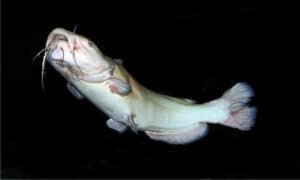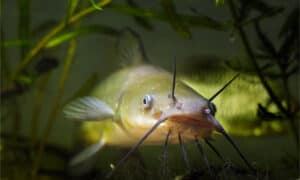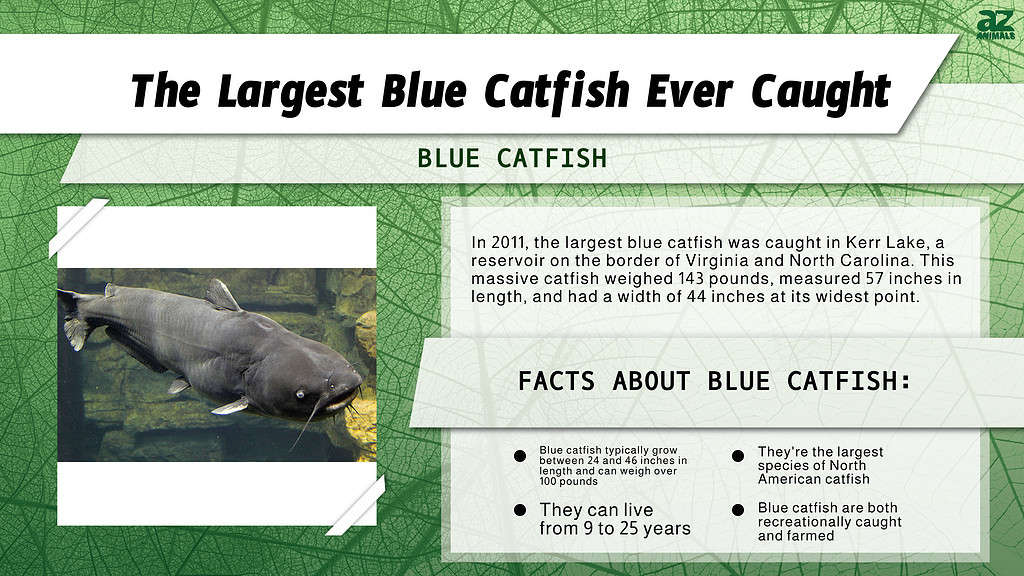
Even normal-sized blue catfish, or Ictalurus furcatus, are big fish. They’re found in Central America and North America, and usually in fresh water, though they can also live in brackish (semi-salty) water.
Originally native to the basins of the Mississippi, Missouri, Ohio, and Rio Grande rivers, blue catfish have been deliberately transplanted to many other regions because they’re so enjoyable to try and catch! Expert anglers love catfishing (and no, we don’t mean impersonating someone on the internet) because these fish are as powerful as they are intelligent — a worthy opponent.
Trawl along with us as we take a deep dive into just how big these big fish can get, and discover the largest blue catfish ever caught!
Blue Catfish Basics
Blue catfish aren’t quite blue, at least not all of the time. They’re more of a dark blueish-gray, with a silvery sheen. Their bellies are white, and they possess a dorsal hump, a protruding upper jaw, barbels (slim, whisker-like sensors near their mouths), and distinctively forked tails. In fact, the second word in the scientific name for blue catfish — furcatus — means “forked”.
They have a number of great nicknames: Chucklehead Cat, Forktail Cat or even Great Forktail Cat, highfin blue, Humpack Blue, Mississippi Cat and silver cat. The main takeaway? This fish looks like a cat. (It’s the barrels!)
Blue Catfish: What It Eats and What Eats It
Catfish are omnivores, eating vegetable matter like algae and other plants, as well as a wide variety of smaller aquatic animals. Blue catfish enjoy snacking on blue crabs, clams, crayfish, frogs, insects, the larvae of mayflies and dragonflies, shad, and pretty much any fish smaller than itself, which is most of them.
Big as they are, they only have a few predators: expert fishing raptors such as osprey and bald eagles, and of course the human beings who love their taste and the thrill of hunting them. Generally, blue catfish are in a comfortable spot on the food chain. If anything, they grow too populous and eat too much of their prey in certain areas such as the Chesapeake Bay. Meanwhile, we probably couldn’t overfish these chucklehead cats even if we tried!

Expert fishing raptors such as osprey prey on blue catfish.
©BlueBarronPhoto/Shutterstock.com
Blue Catfish: Where They Can Be Found
As we say, don’t fear for the blue catfish’s numbers: on the International Union for the Conservation of Nature’s Redlist, you’ll see this species is of “Least Concern” of endangerment. You can find thriving schools of blue catfish throughout the Americas, from Alabama to the Carolinas, the Dakotas, Florida, Guatemala, Illinois, Minnesota, Nebraska, New Mexico, Texas, and Virginia. (In Virginia and Maryland, they’ve over-thrived, 100 million strong. These states now consider the blue catfish an invasive species, as it makes up 70% of fish biomass in the Chesapeake Bay.)
Blue catfish like the deep waters and channels of medium and large rivers. They tend to trawl the bottom of these rivers, amidst the gravelly mud and silt, during the day. At night, they move toward fast-moving water and closer to the surface to hunt and feed. They like clear water with a strong current in the pH range of 5.0 to 7.0 (just a touch on the acidic side).
Blue Catfish: How Big Is Big?
Compared to the average aquatic animal, blue catfish are big! For one thing, they’re the largest species of North American catfish. They normally grow to between 24 and 46 inches long, and many individuals grow to over 100 pounds. After they turn about five years old, the males of the species grow both faster and larger than the females. Given that they can live from 9 to 25 years, blue catfish have plenty of life span in which to pack on all those pounds. This is also part of the reason blue catfish are considered invasive in some places they go: with bodies that large, swells in the blue catfish population add a huge amount of mass — and mouths — to the waters they inhabit.
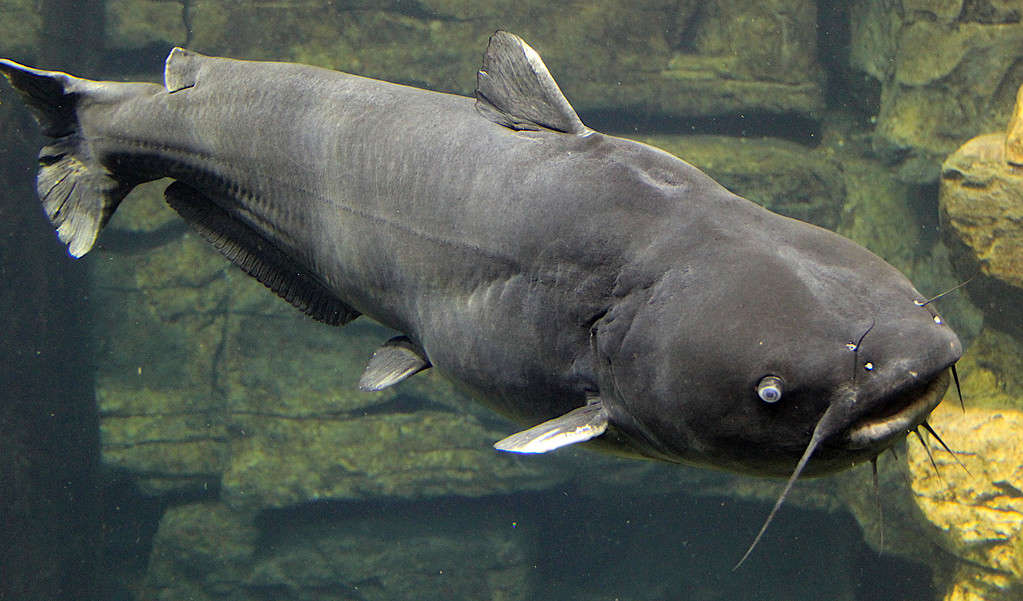
Blue catfish typically grow between 24 and 46 inches in length and can weigh over 100 pounds.
©Thomsonmg2000, cropped and adjusted by Kostka Martin / CC0 – License
How to Catch Blue Catfish
We’ve covered the many places you’ll find blue catfish (though, for the record, the most popular place to fish them is in lakes along the Cumberland River in Kentucky.) They migrate upstream to cooler water in the summer, and downstream to warm up in winter. Blue catfish respond to all kinds of bait. As for mainstream options, they like cut bait, stink bait, grasshoppers, minnows, and nightcrawlers. But fishermen have caught big specimens with more exotic options like cheese, hot dogs, bubble gum, and even chicken liver.
Anglers who know what’s what recommend using trotlines, set lines, limblines, rod-and-reel, or jugs. If you’re using stink or dip bait, they suggest you use a sponge hook.
The Largest Blue Catfish Ever Caught
Angler Richard Anderson bagged the largest blue catfish ever caught in 2011 on Kerr Lake, a reservoir bordering Virginia and North Carolina. The catfish weighed 143 pounds. It measured 57 inches long and was 44 inches around at its widest point (what they call girth). This beat the previous record, set on Lake Moultrie in South Carolina, by about seven pounds.
Kerr Lake is a perfect example of the deliberate, human-made spread of blue catfish. The US Army Corps of Engineers constructed this reservoir in the ’40s and ’50s. Its official use was eventually enhanced by the introduction of blue catfish for recreational fishing.
We mentioned earlier how omnivorous the blue catfish is. This big catch proved it, going for a piece of chicken liver as bait.
Anderson tried to preserve his catch, attempting to keep it alive in a huge tank and intending to donate it to a pro shop as a living exhibit. Unfortunately, the record-setting fish died within the day.
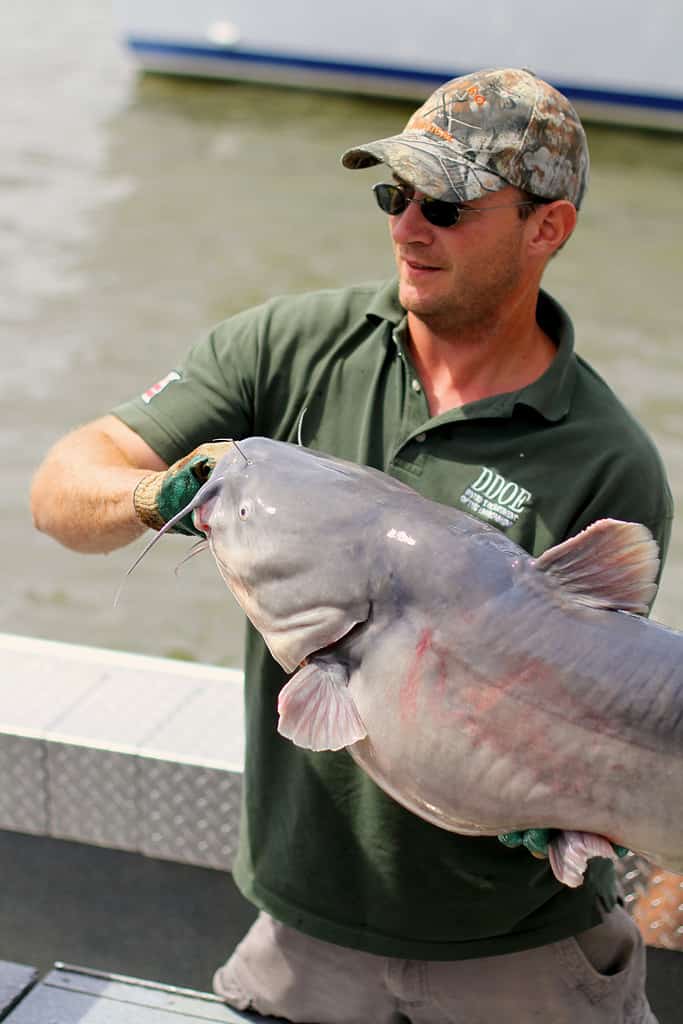
Angler Richard Anderson bagged the largest blue catfish ever recorded in 2011. The catfish weighed 143 pounds.
©U.S. Fish and Wildlife Service Headquarters / Public domain – License
Blue Catfish: Fishing and Cooking
Blue catfish are both recreationally caught and farmed. Remember Virginia and Maryland, where we mentioned blue catfish have become too successful? They’re implementing commercial fisheries to make a bonus out of the Chesapeake Bay situation! This is a relatively new development: as recently as the year 2000, people were neither commercially fishing nor eating blue catfish in great abundance. Yet as Maryland and Virginia realized blue catfish were threatening to destroy many other species in the Chesapeake, and that blue catfish are in fact quite delicious, a plan began to form.
Maryland has led the way in helping to create a commercial fishing industry for blue catfish in the Chesapeake Bay. This should help alleviate the overabundance of the fish here while expanding industry in the area and enriching the local dietary options.
The various local governments whose jurisdiction covers Chesapeake Bay fisheries coordinate their efforts. Their alliance, the Chesapeake Bay Program, serves to manage the blue catfish population in the bay. They’ve even released an Invasive Catfish Management Strategy.
Catfish sometimes get a bad reputation as tasting like mud, because they’re bottom-dwellers. But even those who say they taste mud in its cousin, the channel catfish, will recommend the flavor of blues. Many seafood aficionados consider blue catfish a delicacy, comparing its flavor to the sought-after rockfish and striped bass. Blue catfish can taste a little “fishy” if you leave too much of the fat on. In a typical serving — a four to six-ounce filet — you’ll get a whopping 19 grams of protein and just 1.5 grams of fat, plus all the omega-3 fatty acids you could want. People enjoy blue catfish baked, pan-fried, and, like nearly everything in the Southern US, deep-fried.
The photo featured at the top of this post is © M Huston/Shutterstock.com
Thank you for reading! Have some feedback for us? Contact the AZ Animals editorial team.




